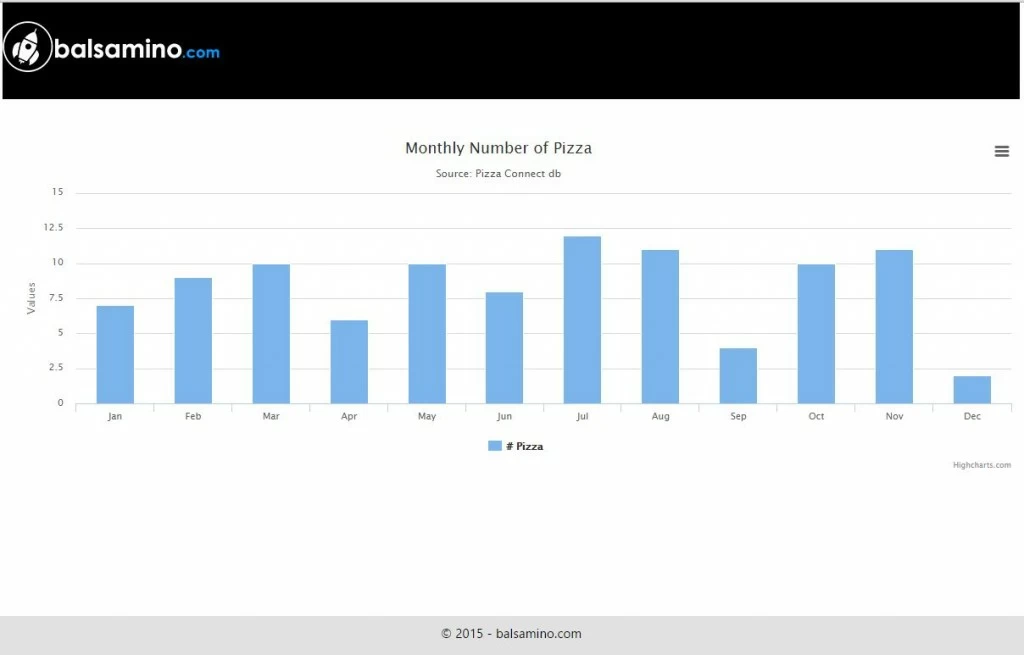HighCharts databinding in C#
Read the previous article about the HighCharts.net component?
Ready to start with the HighCharts discovering?
Ok, let’s start with a very simple project.
I want to draw a line chart populating it with the data stored in a database table (so called databinding).
This tutorial uses data stored in a sql database.
If you need a smart SQL Editor to put in your application back end, you can read my post: C# SQL Editor
News!
- You can find this (an all others) example in my BitBucket public repository balsamino.com examples.
Web form
In order to show the chart I need to include some javascript and to place a literal component on my web form:
<html xmlns="http://www.w3.org/1999/xhtml">
<head runat="server">
<script type="text/javascript" src="http://ajax.googleapis.com/ajax/libs/jquery/1.7.1/jquery.min.js"></script>
<script type="text/javascript" src="http://code.highcharts.com/highcharts.js"></script>
<script type="text/javascript" src="http://code.highcharts.com/modules/exporting.js"></script>
<title></title>
</head>
<body>
<form id="form1" runat="server">
<div>
<asp:Literal id="chrtMyChart" runat="server"></asp:Literal>
</div>
</form>
</body>
</html>Now we have the container chrtMyChart for the chart.
Let’s see the codebehind part.
Codebehind
Add the references at the HighCharts component and create a function called Render_Chart
using DotNet.Highcharts.Enums;
using DotNet.Highcharts.Helpers;
using DotNet.Highcharts.Options;
protected void Render_Chart()
{
......
}Now we need to place the chart inside the Render_Chart:
using DotNet.Highcharts.Enums;
using DotNet.Highcharts.Helpers;
using DotNet.Highcharts.Options;
protected void Render_Chart()
{
DotNet.Highcharts.Highcharts chart = new DotNet.Highcharts.Highcharts("chart")
.InitChart(new Chart { DefaultSeriesType = ChartTypes.Line })
.SetTitle(new Title
{
Text = "Monthly Number of Pizza",
X = -20
})
.SetSubtitle(new Subtitle
{
Text = "Source: Pizza Connect db",
X = -20
})
.SetXAxis(new XAxis
{
Categories = new[] { "Jan", "Feb", "Mar", "Apr", "May", "Jun", "Jul", "Aug", "Sep", "Oct", "Nov", "Dec" }
})
.SetSeries(new[]
{
new Series { Name = "# Pizza.", Data = new Data(chartValues)},
});
chrtMyChart.Text = chart.ToHtmlString(); }The key points are two:
new Series { Name = “# Pizza”, Data = new Data(chartValues)}: here I’ve defined a serie called “# Pizza” declaring that the data will be taken from a chartValues object instead than an array.
ltrChart1.Text = chart.ToHtmlString(): here we render the chart into the literal placed on the webform.
Now is is the time to query the db and to bind the data to the chart.
// define the connection string protected string constring = WebConfigurationManager.ConnectionStrings["myConnectionString"].ToString(); Declare the SQL connection SqlConnection myConn = new SqlConnection(constring); // and add a query string for retrieving the data. string commandText = "select period, count(pizza) from pizzaDB group by period order by period"; SqlCommand myComm = new SqlCommand(commandText, myConn);
Open the connection to the server and execute the query:
myConn.Open(); SqlDataReader reader = myComm.ExecuteReader();
As we know the months in a year are 12, so let’s declare an array of 12 objects in order to store the data from the query:
Object[] chartValues = new Object[12]; // declare an object
if (reader.HasRows)
{
while (reader.Read())
{
// GetValue() returns the data row from the query
// So:
// GetValue(0) will contain the month number [month(eaten_Pizza) as Mese]
// GetValue(1) will contain the number of eaten pizzas [count(eaten_Pizza)]
chartValues[(Int32)reader.GetValue(0)-1] = reader.GetValue(1); // minus 1 because the array starts from 0, whenever the months start from 1
}
}
else
{
Console.WriteLine("No rows found.");
}
reader.Close(); // close the readerSince we have the container for the chart and the object with the data form the dbase, now it is time to render the chart.
protected void Render_Chart()
{
// define the connection string
string constring = WebConfigurationManager.ConnectionStrings["exportDB"].ToString();
// Declare the SQL connection
SqlConnection myConn = new SqlConnection(constring);
// and add a query string for retrieving the data.
string commandText = "select period, count(pizza) from pizzaDB group by period order by period";
SqlCommand myComm = new SqlCommand(commandText, myConn);
// Open the connection
myConn.Open();
// and execute the query
SqlDataReader reader = myComm.ExecuteReader();
Object[] chartValues = new Object[12]; // declare an object for the chart rendering
if (reader.HasRows)
{
while (reader.Read())
{
// GetValue() returns the data row from the query
// So:
// GetValue(0) will contain the month number [<em>month(eaten_Pizza) as Mese</em>]
// GetValue(1) will contain the number of eaten pizzas [<em>count(eaten_Pizza)</em>]
chartValues[(Int32)reader.GetValue(0)-1] = reader.GetValue(1);
// minus 1 because the array starts from 0, whenever the months start from 1
}
}
else
{
Console.WriteLine("No rows found.");
}
reader.Close(); // close the reader
// Declare the HighCharts object
DotNet.Highcharts.Highcharts chart = new DotNet.Highcharts.Highcharts("chart").InitChart(new Chart { DefaultSeriesType = ChartTypes.Column })
.SetTitle(new Title
{
Text = "Monthly Number of Pizza",
X = -20
})
.SetSubtitle(new Subtitle
{
Text = "Source: Pizza Connect db",
X = -20
})
.SetXAxis(new XAxis
{
Categories = new[] {"Jan", "Feb", "Mar", "Apr", "May", "Jun", "Jul", "Aug", "Sep", "Oct", "Nov", "Dec" }
})
.SetSeries(new[]
{
new Series
{
Name = "# Pizza",
Data = new Data(chartValues) // Here we put the dbase data into the chart
},
});
chrtMyChart.Text = chart.ToHtmlString(); // Let's visualize the chart into the webform.
}
}So our task is complete!
This is the output our our work:
Let compact the code for clarity:
using System;
using System.Collections.Generic;
using System.Linq;
using System.Web;
using System.Web.UI;
using System.Web.UI.WebControls;
// Include the HighCharts controls
using DotNet.Highcharts.Enums;
using DotNet.Highcharts.Helpers;
using DotNet.Highcharts.Options;
using System.Web.Configuration;
using System.Data.SqlClient;
namespace balsamino_com.examples
{
public partial class hghchrtsSimpleBind : System.Web.UI.Page
{
protected void Page_Load(object sender, EventArgs e)
{
Render_Chart();
}
protected void Render_Chart()
{
// define the connection string
string constring = WebConfigurationManager.ConnectionStrings["exportDB"].ToString();
// Declare the SQL connection
SqlConnection myConn = new SqlConnection(constring);
// and add a query string for retrieving the data.
string commandText = "select period, count(pizza) from pizzaDB group by period order by period";
SqlCommand myComm = new SqlCommand(commandText, myConn);
// Open the connection
myConn.Open();
// and execute the query
SqlDataReader reader = myComm.ExecuteReader();
Object[] chartValues = new Object[12]; // declare an object for the chart rendering
if (reader.HasRows)
{
while (reader.Read())
{
// GetValue() returns the data row from the query
// So:
// GetValue(0) will contain the month number [<em>month(eaten_Pizza) as Mese</em>]
// GetValue(1) will contain the number of eaten pizzas [<em>count(eaten_Pizza)</em>]
chartValues[(Int32)reader.GetValue(0)-1] = reader.GetValue(1);
// minus 1 because the array starts from 0, whenever the months start from 1
}
}
else
{
Console.WriteLine("No rows found.");
}
reader.Close(); // close the reader
// Declare the HighCharts object
DotNet.Highcharts.Highcharts chart = new DotNet.Highcharts.Highcharts("chart").InitChart(new Chart { DefaultSeriesType = ChartTypes.Column })
.SetTitle(new Title
{
Text = "Monthly Number of Pizza",
X = -20
})
.SetSubtitle(new Subtitle
{
Text = "Source: Pizza Connect db",
X = -20
})
.SetXAxis(new XAxis
{
Categories = new[] {"Jan", "Feb", "Mar", "Apr", "May", "Jun", "Jul", "Aug", "Sep", "Oct", "Nov", "Dec" }
})
.SetSeries(new[]
{
new Series
{
Name = "# Pizza",
Data = new Data(chartValues) // Here we put the dbase data into the chart
},
});
chrtMyChart.Text = chart.ToHtmlString(); // Let's visualize the chart into the webform.
}
}
}| Reference: | HighCharts databinding in C# from our NCG partner Francesco Balsamo at the balsamino.com blog. |





